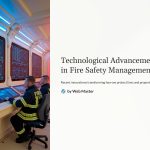 In recent years, the field of fire safety management has experienced significant technological transformations aimed at enhancing efficiency, responsiveness, and overall safety. Staying abreast of these developments is crucial for professionals dedicated to protecting lives and property. This article delves into the most impactful technological changes shaping modern fire safety practices.
In recent years, the field of fire safety management has experienced significant technological transformations aimed at enhancing efficiency, responsiveness, and overall safety. Staying abreast of these developments is crucial for professionals dedicated to protecting lives and property. This article delves into the most impactful technological changes shaping modern fire safety practices.

Integration of IoT and Smart Sensors in Fire Detection Systems
The advent of the Internet of Things (IoT) has revolutionized fire detection methodologies. Modern fire alarm systems now incorporate smart sensors capable of real-time data transmission and analysis. These sensors monitor various environmental parameters such as temperature, smoke density, and air quality, enabling early detection of potential fire hazards. By facilitating immediate alerts and automated responses, IoT integration significantly reduces response times and enhances the effectiveness of fire safety protocols.

Implementation of Artificial Intelligence for Predictive Analysis
Artificial Intelligence (AI) has become a pivotal tool in predicting and mitigating fire risks. AI algorithms analyze historical data, identify patterns, and forecast potential fire incidents. This predictive capability allows organizations to implement proactive measures, allocate resources efficiently, and prioritize inspections in high-risk areas. The integration of AI into fire safety management not only enhances preventive strategies but also optimizes overall operational efficiency.

Adoption of Drones for Firefighting and Surveillance
Unmanned Aerial Vehicles (UAVs), commonly known as drones, have emerged as valuable assets in firefighting operations. Equipped with thermal imaging cameras and sensors, drones provide real-time aerial assessments of fire scenes, aiding in strategic decision-making. They can access hazardous or hard-to-reach areas without endangering personnel, deliver firefighting materials, and monitor fire progression, thereby enhancing situational awareness and operational safety.

Development of Advanced Fire-Resistant Materials
The evolution of fire-resistant materials has significantly contributed to building safety. Innovations in material science have led to the creation of coatings and structural components that can withstand high temperatures and prevent the spread of flames. These advancements are crucial in constructing safer buildings and infrastructure, providing occupants with additional time to evacuate during fire emergencies.

Enhancement of Virtual Reality for Fire Safety Training
Virtual Reality (VR) technology has transformed fire safety training programs. VR simulations offer immersive, realistic scenarios for firefighters and safety personnel to practice emergency responses without real-world risks. This technology enhances learning outcomes, improves decision-making skills under pressure, and ensures that personnel are better prepared for actual fire emergencies.

Integration of Building Information Modeling (BIM) in Fire Safety Planning
Building Information Modeling (BIM) has become an integral part of modern fire safety planning. BIM involves creating digital representations of buildings, allowing for detailed analysis of fire safety measures during the design phase. This technology facilitates the identification of potential hazards, optimization of evacuation routes, and ensures compliance with safety regulations, leading to more resilient building designs.
Learn More About IoT in Fire Safety
Explore AI Applications in Fire Safety
Discover Drone Technology in Firefighting
*Capturing unauthorized imag es is prohibited*
es is prohibited*






